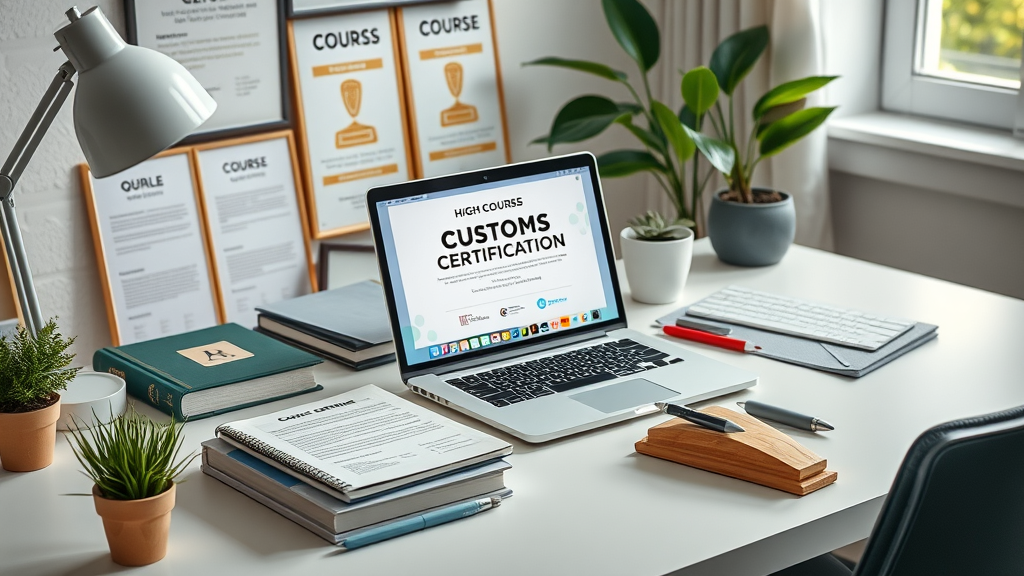Did you know only about 10-15% of applicants pass the customs broker exam on their first attempt? This staggeringly low pass rate highlights just how valuable—and competitive— customs brokerage certification can be for trade professionals ready to level up their careers. In a global economy driven by cross-border transactions, certified customs brokers are in exceptionally high demand. If you’re looking to break into international trade, logistics, or compliance, this guide will illuminate every step—from understanding what it takes to become certified, to succeeding on the challenging broker exam, to unlocking career growth in this thriving field.
Why Pursue Customs Brokerage Certification? Surprising Industry Insights and Opportunities
Achieving a customs brokerage certification isn’t merely about earning a new credential—it’s about gaining a competitive advantage in the bustling world of global trade. Certified customs brokers command respect and trust, as they are specifically trained to navigate complex regulatory requirements, expedite shipments, and prevent costly errors for businesses and clients across borders. Recent trends show a sharp increase in companies prioritizing certified professionals due to evolving international standards, making this credential more crucial than ever for career longevity and growth.
Whether you’re considering becoming a licensed customs broker , an export specialist, or you’re simply passionate about international logistics, understanding the requirements and benefits can reveal unique paths forward. For example, the customs broker exam continues to maintain a low pass rate—typically hovering around 10-15%—underscoring both the rigor and value of the certification. The industry rewards persistence and expertise with positions ranging from entry and compliance to advisory roles with increasing influence over import-export outcomes.
At the heart of customs brokerage certification lies a critical skillset: a keen eye for detail, advanced knowledge of trade regulations, and the agility to respond quickly to dynamic customs environments. Whether navigating a license exam or enhancing trade compliance as a certified customs specialist , this credential is your entry ticket to elevated job prospects, higher earning potential, and global impact.
- Discover how customs brokerage certification can boost your career in trade and logistics
- Understand the current pass rate of the customs broker exam
- Identify essential skills needed for broker license eligibility
- Outline the process to prepare for the customs broker license exam
- Compare LCB and CHB distinctions in customs professionals
"Only about 10-15% of applicants pass the customs broker exam on their first attempt each year, making preparation and certification highly valuable in this competitive field."

Breaking Down Customs Brokerage Certification: What Every Aspirant Should Know
Pursuing customs brokerage certification means committing to a professional standard that opens doors worldwide. A certified customs broker acts as a vital intermediary for importers and exporters, ensuring compliance with union regulations, validating documents, and managing tariffs and entries. To become a certified customs broker , candidates must meet rigorous eligibility requirements, including U.S. citizenship, minimum age (usually 21), and a clean legal record. Many also have a background in supply chain management or international business—experience that enhances industry knowledge and success rate on licensing exams.
The path to success is structured yet flexible. Upon fulfilling prerequisites, candidates must register for the broker license exam, a meticulous assessment covering subjects like the Harmonized Tariff Schedule, valuation, classification, and import regulations. Passing the exam sets a strong foundation for varied career paths—landing roles as brokers, specialists, consultants, or compliance officers. Each designation, from customs broker to export specialist , requires proficiency in complex documentation and a deep understanding of global trade.
The customs broker license exam is comprehensive. Participants will face a blend of multiple-choice and scenario-based questions, directly related to real-world duties. Thorough exam prep using the latest materials is pivotal for success. Still, the rewards are robust: with certification, professionals gain credibility and access to higher-responsibility positions, including advisory or management roles in freight forwarding, import/export operations, and regulatory compliance.
Understanding the Customs Broker Role and Certification Pathways
So, what does a certified customs broker do? Beyond simply preparing paperwork, these professionals verify cargo declarations, classify goods according to the Harmonized Tariff Schedule, advise on duties and taxes, and ensure smooth passage of commodities across borders. The everyday work demands analytical thinking, attention to detail, and up-to-date industry knowledge. Certified customs brokers routinely consult the official website for the latest trade regulations and work closely with government agencies, carrier representatives, and logistics providers.
To obtain customs brokerage certification , applicants must first satisfy eligibility requirements: U.S. citizenship, minimum age of 21, and no prior felony convictions related to customs or trade. The next step is passing the customs broker license exam , a challenging assessment administered by U.S. Customs and Border Protection (CBP). This exam measures knowledge of customs regulations, entry procedures, and trade agreements. Successful candidates become licensed customs brokers , opening up lucrative career paths in customs compliance, logistics, and global trade operations.
Certified professionals then choose specialization tracks: some step into roles as certified export specialists, supporting complex export documentation, while others master compliance as certified customs specialists. These distinctions create a well-rounded trade community in which brokers, export specialists, and customs specialists collaborate closely to enhance industry standards worldwide.
- What does a certified customs broker do?
- Requirements for obtaining customs brokerage certification
- Career paths as a customs broker or export specialist
- Overview of the customs broker license exam content
| Certification | Description | Required Exam | Typical Roles |
|---|---|---|---|
| LCB | Licensed Customs Broker (U.S.) | Broker License Exam | Entry, compliance, representation |
| CHB | Customs House Broker (international) | Broker License Exam | Entry, logistics, customs advisory |
| CES | Certified Export Specialist | Export Certification Exam | Export documentation, consultation |

Passing the Customs Broker Exam: What to Expect and How to Succeed
For anyone seeking customs brokerage certification , the customs broker exam is the most significant hurdle—and one of the toughest licensing exams in U.S. trade compliance. The test is administered twice annually by the CBP and covers a wide range of topics, including customs regulations, classification, valuation, and penalty provisions. Structured as a four-hour, open-book exam, candidates answer 80 multiple-choice questions, pulling information from the official website and published CBP materials.
Because the pass rate remains low—usually under 15%— exam prep cannot be overstated. Preparation is key to increase your chances of joining those who have passed the exam and become licensed customs brokers. Common hurdles include understanding complex federal regulations, interpreting legal jargon, and staying updated on dynamic trade laws. However, diligent study, using practice exams and updated study guides, can make all the difference. Organizing a structured exam prep schedule well before scheduled exam dates—and registering through the CBP gov website —sets a strong foundation for success.
Applicants can choose among multiple exam locations—ranging from major trade hubs such as Los Angeles to smaller regional CBP facilities. The process is streamlined online, where candidates must submit detailed applications, credentials, and fees. The CBP posts schedules and deadlines on the official website , and early registration is highly recommended due to limited seating.
Broker Exam Structure, Pass Rate, and Registration Details
The structure of the broker license exam is designed to evaluate a candidate's mastery of customs procedures, compliance, and entry processing. Questions are complex and rooted in practical, real-world trade scenarios. The exam includes material on legal responsibilities, recordkeeping, classification, and the use of the Harmonized Tariff Schedule—a must-know subject matter for aspiring brokers.
With only a 10-15% pass rate , taking the exam requires a strategic approach. Many candidates have to sit for the licensing exam more than once before passing. As such, scheduling regular study sessions, using reliable exam prep resources, and joining study groups can greatly enhance comprehension. Registration for the broker exam is typically available on the CBP's gov website , and the process is clearly outlined for both new and returning applicants.
To maximize your chance of success, familiarize yourself with exam timelines, important dates, and application requirements—including submission of identification, proof of citizenship, and fee payments. Allow ample time to prepare; last-minute cramming is rarely effective for such a comprehensive licensing exam.
- Breakdown of exam prep resources for the customs broker exam
- Common hurdles and how to overcome them
- Exam dates, locations, and application process

Effective Exam Prep Strategies for Customs Broker Certification
Success on the customs broker license exam is built on a foundation of effective, up-to-date exam prep . Begin by prioritizing the latest CBP study materials and reference books, ensuring nothing is overlooked given regulatory updates. Many candidates benefit from enrolling in specialized customs specialist training courses offered by professional organizations or trade-focused colleges, providing expert-led instruction on technical subject matter.
Practice is essential—complete multiple practice tests that replicate actual exam questions and timing. Simulated tests boost familiarity with question formats and allow you to pinpoint areas needing improvement. Leveraging resources from licensed customs brokers and certified export specialists can also deliver valuable perspective—many professionals are willing to offer insights into exam day strategies and career development.
Finally, network with like-minded peers: online communities and forums dedicated to customs broker exam prep or trade compliance help candidates exchange tips, share resources, and foster accountability. Remember, persistence and diligence are key. With a solid regimen, you can increase your chances of joining the select group that has passed the exam and earned the coveted broker license.
- Prioritize updated study materials for broker license exam
- Engage in specialized customs specialist training courses
- Leverage practice tests for the customs broker license exam
- Connect with certified customs specialists and export professionals for insights

Comparing Customs Specialists: Certified Customs Broker vs. Export Specialist
Customs brokerage certification offers versatility in career specialization, allowing professionals to tailor their careers as either import-focused brokers or export-oriented specialists. A customs broker typically deals with regulatory compliance, documentation for imports, and consulting with clients on customs entry, whereas an export specialist specializes in compliance, documentation, and logistics processes for exporting goods abroad. Both roles are vital within the trade community and often collaborate with freight forwarders and compliance officers to streamline global commerce.
Certification also opens a path to become a certified customs specialist . This role typically involves conducting in-depth research into trade rules, ensuring company-wide compliance, and training teams on best practices in international shipping. Each position—whether as a broker, export specialist, or customs specialist—has distinct certification standards and responsibilities, yet all play a central role in modern supply chains and regulatory oversight.
Understanding the differences in responsibilities and regulatory scope is essential for selecting the pathway that aligns with your interests and long-term career objectives. The following table illustrates the key distinctions in certification and roles:
| Position | Main Focus | Certification Required |
|---|---|---|
| Customs Broker | Import processes, customs entry | Broker License |
| Export Specialist | Export compliance, documentation | Export Certification |
| Certified Customs Specialist | In-depth trade compliance | Customs Specialist Certificate |
Career Growth After Customs Brokerage Certification: Industry Trends and Salary Insights
The value of customs brokerage certification extends far beyond a single exam or credential—it’s a springboard to rewarding opportunities in a rapidly changing economic landscape. Newly certified customs brokers can pursue positions in large corporations, freight forwarders, and government agencies, with demand strongest in global trade centers. Emerging roles include customs compliance manager, global logistics coordinator, and trade consultant, each offering progression to management tracks.
Certified professionals enjoy a tangible bump in earning power, as companies increasingly seek out licensed individuals to navigate tightening trade laws and customs procedures. Entry-level salaries for licensed customs brokers are competitive, with experienced professionals and managers earning six-figure salaries, especially in major trade hubs like Los Angeles and New York. A growing emphasis on trade facilitation and regulatory oversight ensures job security and the chance to impact international business outcomes.
Real-world success stories are abundant, with testimonials touting career transformation and stability following certification. As regulatory frameworks continue to evolve, the demand for customs specialists grows. Preparation, perseverance, and certification ensure that motivated professionals can claim a pivotal role in the future of world trade.
- Emerging roles for certified customs brokers and export specialists
- How customs brokerage certification impacts earning potential
- Real-world success stories and testimonials from certified customs professionals
"Achieving customs brokerage certification was transformational for my career—demand for qualified customs brokers continues to grow as trade regulations evolve."

People Also Ask: Your Most Common Customs Brokerage Certification Questions
What is a certified customs broker?
A certified customs broker is a licensed professional authorized by the U.S. government or appropriate international agency to facilitate the importation and exportation of goods. They prepare and submit necessary documents, ensure compliance with all applicable laws, and help clients navigate complex trade regulations. Most certified customs brokers have demonstrated their expertise by passing a rigorous customs broker license exam and maintaining current industry knowledge through ongoing education.
How difficult is the customs broker exam?
The customs broker exam is known for its rigor and breadth of subject matter, covering various regulations, processes, and compliance matters. With a national pass rate averaging only 10-15%, it is regarded as one of the most challenging licensing exams in the trade community. The exam requires extensive study, attention to legal detail, and thorough familiarity with customs rules, making targeted exam prep crucial to success.
What is the difference between LCB and CHB?
An LCB (Licensed Customs Broker) is certified by the U.S. Customs and Border Protection to operate within the United States, focusing mainly on U.S. import regulations and compliance. A CHB (Customs House Broker), meanwhile, can refer to a similar role on the international stage or in countries outside the U.S., often with slightly different requirements depending on the regulatory body. Both require passing a broker license exam relevant to their jurisdiction.
How do I become a licensed customs broker?
To become a licensed customs broker, you must typically be a U.S. citizen, be at least 21 years old, and have no felony convictions. The process involves preparing for and passing the customs broker license exam, then applying for your broker's license through the U.S. Customs and Border Protection’s official website. Maintaining your license may require continuing education and staying current on the changing trade landscape.
Essential Resources and Exam Prep Tools for Customs Brokerage Certification
Top-quality exam prep resources are essential for passing the customs broker exam and securing your certification. Begin with top-rated customs broker exam prep books and comprehensive online courses—many providers even offer mock tests that simulate real scenarios. Official customs brokerage certification exam guides, such as those from the CBP’s official website, are indispensable for accurate information and practice questions. Practice exams provide both reassurance and valuable feedback, highlighting weaker areas that need further review.
Online communities also play a vital role—networking with other candidates, certified customs brokers, and export specialists accelerates learning and provides moral support. Trade associations frequently share updates, resource lists, and job postings, keeping candidates engaged with the wider industry. Investing in reliable study materials and seeking out mentorship, especially from individuals who have recently passed the exam, can help demystify challenging concepts and bolster your confidence ahead of exam day.
- Top-rated customs broker exam prep books and courses
- Official customs brokerage certification exam guides
- Online communities for customs brokers and export specialists
- Practice exams for broker license and customs broker license exams

Take the Next Step: Advance Your Career with Customs Brokerage Certification
Obtaining your customs brokerage certification is not just a milestone, but a transformative investment in your professional future. As the world grows smaller and supply chains become more interconnected, the need for trusted customs professionals will only intensify. Mastering exam prep, deepening your industry knowledge, and gaining hands-on experience will ensure your place as a critical resource—no matter where the global marketplace leads.
Frequently Asked Questions on Customs Brokerage Certification and Career Progression
- Can foreign nationals obtain customs brokerage certification?
- How long does it take to prepare for the customs broker license exam?
- What continuing education is required to maintain certification?
- What are the top industries hiring certified customs brokers today?
Can foreign nationals obtain customs brokerage certification? Most countries require customs brokers to be citizens or permanent residents. In the United States, only U.S. citizens are eligible. Requirements vary internationally, so check the relevant gov website where you wish to practice.
How long does it take to prepare for the customs broker license exam? Typical preparation time for the exam ranges from two to six months, depending on prior knowledge and experience. A structured study plan, practice exams, and participation in training courses are recommended for success.
What continuing education is required to maintain certification? Continuing education requirements depend on jurisdiction. Many U.S. brokers voluntarily pursue training or attend industry seminars to stay current with ever-evolving trade regulations and to keep their knowledge updated.
What are the top industries hiring certified customs brokers today? Industries hiring certified customs brokers include freight forwarding, logistics and supply chain management, multinational manufacturing, import/export consultancies, and customs compliance departments at large corporations.
Key Takeaways for Unlocking Success with Customs Brokerage Certification
- Customs brokerage certification dramatically increases job prospects in global trade
- Passing the customs broker exam requires focused exam prep and diligent study
- Certified customs brokers play a critical role in regulatory compliance
- Multiple certification and licensing options exist for customs and export specialists
Get Started on Your Customs Brokerage Certification Journey
Ready to unlock your future as a leader in international trade? Begin your journey by reviewing official customs broker exam material, focusing your exam prep, and connecting with experienced professionals. Whether you’re just starting or looking to advance quickly, customs brokerage certification is your ticket to a high-impact, well-compensated career. Have insights to share on global trade? Let's talk—call us at 203-271-7991 to explore contributing an article.
Customs Brokerage Certification Explained: Comprehensive Video Learning
Visual learners: explore online video lessons or tutorials for a step-by-step review of customs brokerage concepts. These resources often break down complex customs regulations, illustrate real-world scenarios, and help clarify exam topics—making them excellent supplements to your traditional study regimen.
How to Prepare for the Customs Broker Exam: Step-by-Step Video Guide
Looking for actionable, stepwise exam prep strategies? Online video walkthroughs guide you through sample test questions, review effective study habits, and demonstrate common pitfalls to avoid on exam day. Combining visual and textual study aids gives you the best chance at passing the customs broker license exam and earning your certification.
To enhance your understanding of customs brokerage certification, consider exploring the following authoritative resources:
-
“Becoming a Customs Broker” : This official U.S. Customs and Border Protection (CBP) page outlines the eligibility criteria, application process, and responsibilities associated with becoming a licensed customs broker. ( cbp.gov )
-
“Customs Broker License Examination (CBLE)” : Provided by Pearson VUE, this resource details the structure, content, and scheduling of the CBLE, offering insights into the examination process and preparation strategies. ( pearsonvue.com )
These resources offer comprehensive information to guide you through the certification journey, from understanding the role and requirements to preparing effectively for the licensing exam.
 Add Row
Add Row  Add
Add 




Write A Comment